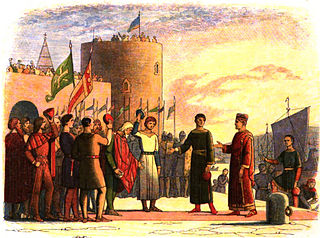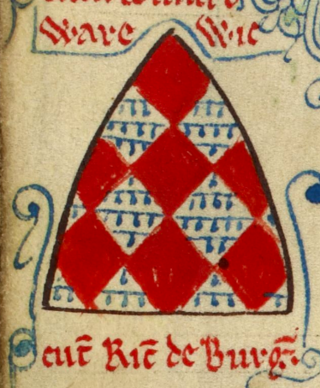Contents
| |||||
| Centuries: | |||||
|---|---|---|---|---|---|
| Decades: | |||||
| See also: | Other events of 1312 List of years in Ireland | ||||
Events from the year 1312 in Ireland.
| |||||
| Centuries: | |||||
|---|---|---|---|---|---|
| Decades: | |||||
| See also: | Other events of 1312 List of years in Ireland | ||||
Events from the year 1312 in Ireland.

Year 1171 (MCLXXI) was a common year starting on Friday of the Julian calendar.

Hubert de Burgh, Earl of Kent was an English nobleman who served as Chief Justiciar of England (1215–1232) and Justiciar of Ireland (1232) during the reigns of King John and his son and successor King Henry III and, as Regent of England (1219–1227) during Henry's minority, was one of the most influential and powerful men in English politics in the thirteenth century.

William Longespée, 3rd Earl of Salisbury was an Anglo-Norman nobleman, primarily remembered for his command of the English forces at the Battle of Damme and for remaining loyal to his half-brother, King John. His nickname "Longespée" is generally taken as a reference to his great physical height and the oversized weapons that he used.
Justiciar is the English form of the medieval Latin term justiciarius or justitiarius. The Chief Justiciar was the king's chief minister, roughly equivalent to a modern Prime Minister of the United Kingdom.
Geoffrey Fitz Peter, Earl of Essex was a prominent member of the government of England during the reigns of Richard I and John. The patronymic is sometimes rendered Fitz Piers, for he was the son of Piers de Lutegareshale, a forester of Ludgershall and Maud de Manderville.
Thomas Charlton was Bishop of Hereford, Lord High Treasurer of England, Lord Privy Seal, and Lord Chancellor of Ireland. He is buried in Hereford Cathedral in Hereford, Herefordshire, England.

Hugh Bigod was a member of the powerful early Norman Bigod family and was for a short time the 3rd Earl of Norfolk.

Richard Mór de Burgh, 1st Lord of Connacht, was an Anglo-Norman aristocrat who was Seneschal of Munster and Justiciar of Ireland (1228–32).

Walter de Lacy was lord of Meath in Ireland. He was also a substantial land owner in Weobley, Herefordshire, in Ludlow, Shropshire, in Ewyas Lacy in the Welsh Marches, and several lands in Normandy. He was the eldest son of Hugh de Lacy, a leading Cambro-Norman baron in the Norman invasion of Ireland, and Rohese of Monmouth.
Events from the year 1345 in Ireland.
The following is a list of events that occurred in the year 1344 in Ireland.
Events from the year 1342 in Ireland.
Events from the year 1341 in Ireland.
Events from the year 1337 in Ireland.

Theobald Walter was the first Chief Butler of Ireland. He also held the office of Chief Butler of England and was the High Sheriff of Lancashire for 1194. Theobald was the first to use the surname Butler of the Butler family of Ireland. He was involved in the Irish campaigns of King Henry II of England and John of England. His eldest brother Hubert Walter became the Archbishop of Canterbury and justiciar and Lord Chancellor of England.
Events from the 1180s in England.
Edmund Butler, 6th Chief Butler of Ireland and nominally Earl of Carrick, was an Irish magnate who served as Justiciar of Ireland during the difficult times of the Scottish invasion from 1315 to 1318 and the great famine of 1316 to 1317.
Walter de Thornbury was an English-born statesman and cleric who held the office of Lord Chancellor of Ireland in the 14th century. His efforts to secure confirmation of his election as Archbishop of Dublin ended in tragedy with his death in a shipwreck.

Sir John Wogan or John de Wogan, styled lord of Picton was a Cambro-Norman judge who served as Justiciar of Ireland from 1295 to 1313. There are several dubious theories about Wogan's ancestry, and uncertainty exists about his wives, sons, and other relations. He came from Picton in Pembrokeshire and was a vassal of William de Valence, 1st Earl of Pembroke. He came to have lands in Pembrokeshire, Somerset, Dorset, Devon, Wiltshire, and Oxfordshire. He may have represented de Valence at an Irish court case in 1275, and in 1280 he was steward of Wexford, Valence's Irish liberty. He was a justice in eyre in England in 1281–4, and returned to Ireland in 1285. In 1290 he was a referee with Hugh Cressingham in a dispute between Queen Eleanor and de Valence and his wife. He was on eyre again in the mid-1290s, sitting in the North of England.
Walter de Cusack was an Anglo-Irish judge, magnate and military commander of the fourteenth century.